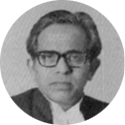Y.V. Chandrachud

Y.V. Chandrachud
16th Chief Justice of India
Assumed Office28th Aug, 1972
Retired On11th Jul, 1985
Previously
Permanent Judge of the Bombay High CourtDecember 21st 1961-August 27th 1972
Judge of the Bombay High CourtMarch 19th 1961-December 20th 1961
Enrolment1943
Profile
Justice Yeshwant Vishnu Chandrachud served as the 16th Chief Justice of the Supreme Court from 1978 to 1985. He is the longest-serving Chief Justice in India’s history, at seven years and four months.
He was born on July 12th 1920 in Pune. He completed his graduation in history and economics in 1940 from Elphinstone College, Bombay and obtained his law degree in 1942 from ILS Law College, Pune.
He enrolled as an advocate in the High Court of Bombay in 1943. He was a part-time Professor of Law in Government Law College, Bombay, from 1949 to 1952. He was appointed as a Judge at the Bombay High Court in 1961 and Judge at the Supreme Court in 1972. He was appointed as the Chief Justice of India in 1978. Chandrachud J was appointed during the term of the Janta Government. When the Indira Gandhi government came to power, he became a strong opponent of the government.
During his tenure as Chief Justice of India, he oversaw many landmark cases, one of which was the Kissa Kursi Ka case, where Sanjay Gandhi was remanded to 30 days in judicial custody by the Supreme Court. It was this ruling that undid the perception that the judiciary had capitulated to political influence.
During his time as a Supreme Court judge, Justice Chandrachud authored a total of 338 judgments. He authored the most judgments in 1977 (48).
In K.S. Puttaswamy v UOI (2017), his landmark case A.D.M. Jalbalpur v Shivakant Shukla (1976) was overruled by Justice D.Y. Chandrachud. A nine-judge Constitution Bench headed by Justice D.Y. Chandrachud said that privacy is a fundamental right, overruling the 1976 verdict and terming it as “seriously flawed.”
Notable Judgments
In Minerva Mills Ltd. v Union of India (1980) a five-judge Bench decided on the constitutionality of the Constitution (42nd Amendment) Act, 1976. Chandrachud J ruled that under Article 368 of the Constitution, Parliament cannot expand its amending power to acquire for itself the right to repeal or abrogate the Constitution or to destroy its basic and essential features.
In Gurbaksh Singh Sibbia v State of Punjab (1980) a five-judge Bench was adjudicating on laws of anticipatory bail. Chandrachud J held that laws on anticipatory bail must be read in light of Article 21 of the Indian Constitution. The court can impose restrictions on the grant of bail on a case-by-case basis.
In Mohd. Ahmed Khan v Shah Bano Begum (1985) a five-judge Bench headed by Chandrachud J adjudicated on the maintenance rights of divorced Muslim women. The Bench that the obligation imposed by s 125 of the Criminal Procedure Code to maintain indigent close relatives applied to all citizens irrespective of religion.
In Olga Tellis v Bombay Municipal Corporation (1985) a five-judge Bench headed by Chandrachud J expanded the scope of the Right to Life under the Indian Constitution. The Bench ruled that the Right to Life includes the Right to Livelihood.
In A.D.M. Jalbalpur v Shivakant Shukla (1976), famously known as the ‘Habeas Corpus case’, a five-judge Bench decided that the Right to Life under the Indian Constitution could be suspended during an Emergency.
